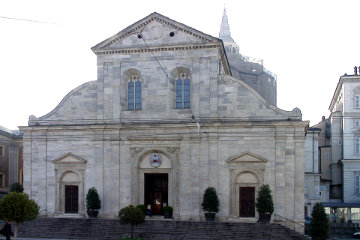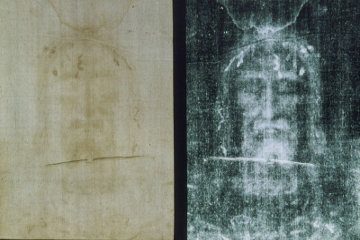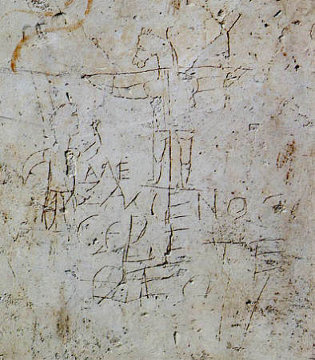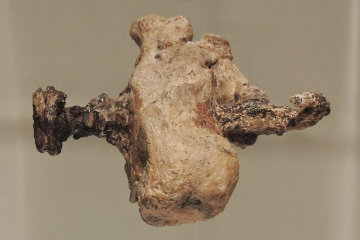The Golden Ass and the Turin Shroud
Some years ago I had occasion to travel across the north of Italy from Trieste in the east to Turin in the west. I had been giving a series of lectures in Croatia, which is why I started in the east, and wanted to visit the Waldensian Valleys, which are in the west. However I was aware that Turin has an archaeological museum with a famous collection of Egyptian artefacts and decided to visit that on my way.

| |
| The exterior of Turin cathedral, where the Holy Shroud is housed. |
I arrived in Turin fairly late in the day, so it wasn't until the morning that I was able to park my car on the outskirts of town and walk into the town centre, where I discovered that the museum keeps disgracefully late hours and doesn't open until 9.00 in the morning - and this was 7.30. To fill in the time, therefore, I wandered around the city, which has some fine architecture. The rows of shops were mostly closed, though the cafes and coffee shops were just starting to serve their first customers. I strolled past a huge castle in the middle of a large square and then saw a sign pointing to "duomo", with the added attraction of a "theatro Romano", and figured that a church was likely to be open and might contain a monument or two worth the viewing.
It wasn't until I was actually inside the building and saw the signs and information boards that I remembered that Turin is home to the famous "Shroud of Turin", a piece of cloth about 14' long and 3'6" wide on which is a rather curious image of a man. The man's head is approximately in the middle of the cloth and is shown twice; in one image you see the man's face and stretching down towards the end of the cloth you see the front of his body with his hands neatly crossed over his groin and his feet at the far end of the cloth. In the other image you see the back of the man's head and the back of his body with his feet at the other end of the cloth.
According to Catholic belief, this is the shroud in which the body of Jesus was wrapped at the time of His burial. The image has been interpreted that the body was laid on its back on the cloth with the feet at one end and the head towards the middle. The cloth was then drawn up and over the head to cover the body, with the natural result that the front of the feet was towards the other end of the cloth. Various dark markings on the cloth are claimed to be blood stains from the crown of thorns placed on Jesus' head, the nails that fastened Him to the cross and the spear thrust through His side which confirmed that He was dead.

|
| The Turin Shroud - digitally processed to make the image appear slightly more prominently. |
This shroud was dismissed by Protestants (and even a few sceptical Catholics) as yet another pious fraud by the Catholic church until 1898 when an amateur photographer named Secondo Pio was given permission by the Prince of Savoy - the shroud was owned by the House of Savoy - to photograph the object. In those days photography was a rather heroic endeavour involving glass plates and wooden cameras the size of a small chest. In the gloom of the cathedral Pio was obliged to use another recent invention, electrictricity, to provide enough light and that meant hiring a generator and setting it up outside the cathedral.
It was when Pio developed his plates that he received the shock of his life and sindology or the study of the shroud, began. To understand why Pio was shocked I need to explain about photography, an explanation that will be redundant to anyone of my age and probably incomprehensible to the younger generation with their iPhones and digital cameras.

| |
| The face in the Shroud - on the left by natural light, on the right in the negative image. |
Just as iron explosed to oxygen will rust, so silver exposed to light will turn black. Usually this process takes a long time, which is why your silver cutlery only needs polishing occasionally, but by immersing the silver in certain chemicals the process can be speeded up considerably. The earliest photography was done by coating a glass plate with emulsion - a jelly "flavoured" with silver halides. This is done in complete darkness. When the plate was exposed to light - and early photographs required exposures of several minutes - the silver halides were changed and this change could be magnified by soaking the plate and its jelly in a chemical called a developer. (You then have to soak the plate in another chemical called a fixer, which removes any unaffected silver, leaving only the blackened silver behind to form the image.)
Consider a photograph of a lump of coal side by side with a lump of pure white marble. There is virtually no light reflected from the coal and so in the part of the plate corresponding to the coal, almost none of the silver will have been affected. Once you have processed the plate, the coal will appear as white. On the other hand the marble reflects a lot of light and on the plate a lot of the silver will have turned black. This is called a negative image.

| |
| A glass-plate negative on the left and its positive image on the right. |
To produce the required positive image you have to project the negative onto a piece of paper coated with the same sort of silver-flavoured jelly. This time the blackened silver of the negative prevents any light passing through and the lump of marble appears white, while the lack of silver allows light through and the lump of coal appears black.
All clear so far?
Anyone who engaged in photography up until the 1990s or beyond will be familiar with negatives; when you took your film in to be developed you were given a pack containing the 36 photographs and also your film, cut up into strips and showing the negative images. Once you had chosen which image of Aunty Maud you wanted, you could return the film to the chemist and have it reproduced larger or on silk-effect instead of glossy paper. It was often confusing, however, to tell which negative to use because although Aunty Maud's grimace instead of a smile was apparent in the positive, it was less easy to recognise it in the negative.
When Pio developed his plates and held them up to the light to examine them, he expected to see a similar confusing negative image. Instead what he saw was a positive image of a man's face and ever since then debate has raged over how an artist - presumably mediaeval - could have produced this effect or, indeed, why he might have chosen to do so! Wikipedia has a lengthy article about the shroud and the various attempts to reproduce the extraordinary image on it.
Many years ago I read a book about the shroud which argued strongly that the cloth was a genuine 1st century AD shroud used to cover the body of Jesus. One of the arguments advanced was the fact that the shroud clearly showed a wound in the wrist rather than in the hand. According to the author - and I cannot remember whether he cited evidence to support his assertion - a man could not be crucified by nails through the palms of his hands, as his body weight would be sufficient to tear the flesh and cause him to fall from the cross.

| |
| Alexamenos adores his god |
This was an interesting argument. The earliest Christians did not use the cross as a symbol - as someone has remarked, it would be the equivalent of adopting a gallows or an electric chair as the symbol of your religion and having model gallows on the altar of your churches or pinned to the lapels of your garments. In fact, the earliest representation of a cross comes from the insulting "Alexamenos adores his god" scratched into the plaster of a building on the Palatine Hill in Rome, which is not sufficiently detailed to allow any conclusions to be drawn about the site of the nails.
The symbol of the crucifix - the figure of a man nailed to a cross - began to be used about the 5th century AD and invariably depicts Jesus with nails through the palms of His hands and penetrating His feet from the top of the foot through to the sole of the foot. If it was true that the palm of the hand was too fragile to allow of crucifixion by nails through the palm, then the fact that the Turin shroud depicted a wound in the forearm - which was robust enough to bear a person's weight - was a good argument in favour of its genuineness. Any mediaeval artist would have simply copied the traditional crucifix and painted the wound in the palm of the figure's hands.

| |
| The heel bone of the unfortunate Yehohanan ben Hagkol in the Rockerfeller Museum in Jerusalem. |
At the time this book was written the ossuary of Yehohanan son of Hagkol was not widely known. The shroud shows wounds in the feet of the body in accordance with the traditional crucifix. The bones of Yehohanan, however, were discovered with a nail still in position. The unfortunate Yehohanan was fastened to his cross by nails through his heels. (Interestingly, when I broke my leg rather badly a few years ago and had to be placed in traction for several weeks, the weight was attached to my foot by a pin through my heel in the same location as the nail through Yehoahan's heel. It gave me a certain sympathy for poor old Yehohanan!)
Of course, crucifixion methods doubtless varied depending on local customs or the techniques of the particular executioner. Initial reports that Yehohanan had been fastened to his cross by nails through his forearms - as depicted by the shroud - were discounted by a re-examination of the bones by Joe Zias and Dr Eliezer Sekeles. They concluded that there were no marks consistent with nails through either hand or forearm and that Yehohanan's hands had been tied to his cross. It is, therefore, possible that Yehohanan was nailed through his heels while Jesus was nailed through His feet.
I was interested, therefore, to come across a curious statement in The Golden Ass by the Roman author Apuleius. Lucius, the hero of the novel, admits to a fascination with witchcraft and when he discovers that the wife of his host is a noted local witch, he persuades the family slave-girl - whom he has seduced - to show him some of the woman's secrets. Fotis, the slave girl, describes the woman's magic lair.
She had everything ready there for her deadly rites: all sorts of aromatic incense, metal plaques engraved with secret signs, beaks and claws of il-omened birds, various bits of corpse-flesh - in one place she had arranged the noses and fingers of crucified men, in another the nails that had been drive through the palms and ankles, with bits of flesh still sticking to them - also little bladders of life-blood saved from the men she had murderd and the skulls of criminals who had been thrown to the wild beasts in the amphitheatre."
Apuleius, The Golden Ass tr. Robert Graves p.85
Unfortunately, Robert Graves' translation, although easy to read, is also more idiomatic than accurate. I am no Latinist and the garbage produced by Google Translate when it attempts Latin has to be seen to be believed! Nevertheless, it appears that the old translation by William Adlington, made in 1566 is a more accurate rendition of the original Latin.
Preparing her selfe according to her accustomed practise, she gathered together all substance for fumigations, she brought forth plates of mettal carved with strange characters, she prepared the bones of such as were drowned by tempest in the seas, she made ready the members of dead men, as the nosethrils and fingers, she set out the lumps of flesh of such as were hanged, the blood which she had reserved of such as were slaine and the jaw bones and teeth of willed beasts.
There does not appear to be anything in the Latin original to conform to Graves' "palms and ankles". We might assume that he referred to "ankles" on the basis of Yohannan bar-Hagkol, but where does the "palms" come from? The first reports of that ossuary claimed that the unfortunate Jew had been crucified by nails through his forearms, just as the Turin Shroud depicts. If Graves used the one detail from the ossuary, it is surprising that he did not use the other!
Surprising, but gratifying. A decade or so ago the National Geographic Channel produced a documentary called "The Quest for Truth: The Cricifixion". The conclusion was that nailing the victim's heels to the cross enabled all his weight to be born on his feet. There would be neglible weight on his hands or wrists, so either could be nailed to the cross. Hands were an easier target and, for sadistic-minded executioners, were considerably more painful. With a strip of wood between the flesh and the head of the nail there was virtually no danger that the flesh would tear, allowing the victim's hands to come free.
So where does this leave us? Well, the archaeological as well as the experimental evidence seems clear: unlike the traditional crucifix and the Turin Shroud, nails were not hammered through the feet from top to sole. They were hammered through the heel and the feet were fastened to the sides, not the front, of the cross. Although there is no archaeological evidence for the hands, there appears no practical reason why hands, rather than forearms, should not have been nailed to the cross. Certainly the gospel evidence appears clear that Jesus was nailed through the hands.
While they were still talking about this, Jesus Himself stood among them and said to them, "Peace be with you."
They were startled and frightened, thinking they saw a ghost. He said to them, "Why are you troubled, and why do doubts rise in your minds? Look at My hands and My feet. It is I Myself! Touch Me and see; a ghost does not have flesh and bones, as you see I have."When He had said this, He showed them His hands and feet.
Luke 24:26-40
Doubting Thomas specifically mentions hands.
Now Thomas (also known as Didymus), one of the Twelve, was not with the disciples when Jesus came. So the other disciples told him, "We have seen the Lord!"
But he said to them, "Unless I see the nail marks in His hands and put my finger where the nails were, and put my hand into His side, I will not believe."A week later his disciples were in the house again, and Thomas was with them. Though the doors were locked, Jesus came and stood among them and said, "Peace be with you!"
Then He said to Thomas, "Put your finger here; see My hands. Reach out your hand and put it into My side. Stop doubting and believe."John 20:24-27
It would seem, then, that on both counts the Turin Shroud contradicts what we know about crucifixion in general and the crucifixion of Jesus in particular. A pity, as the idea of the mysterious shroud is actually rather appealing, but as whoever it was said, "Facts is facts".
© Kendall K. Down 2016





